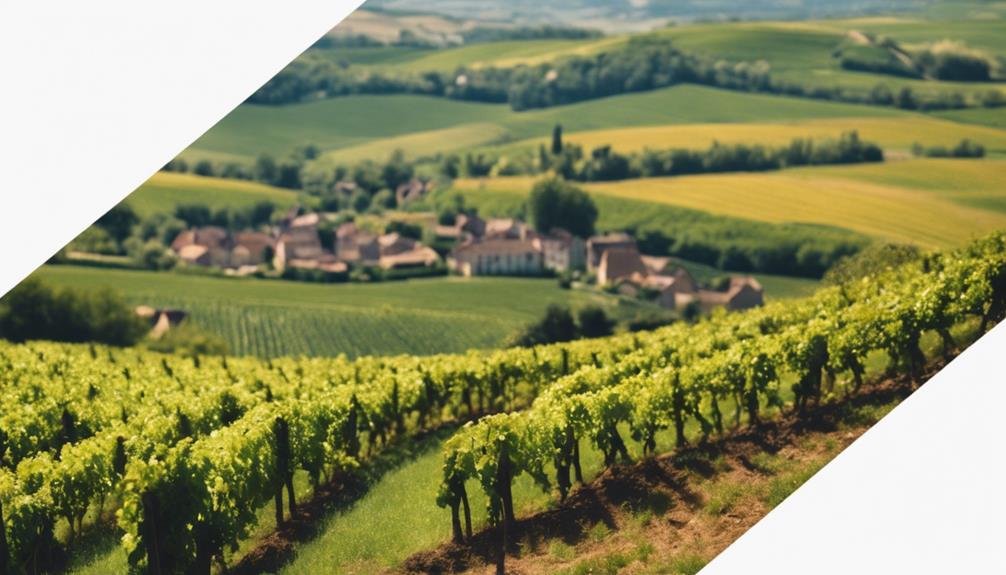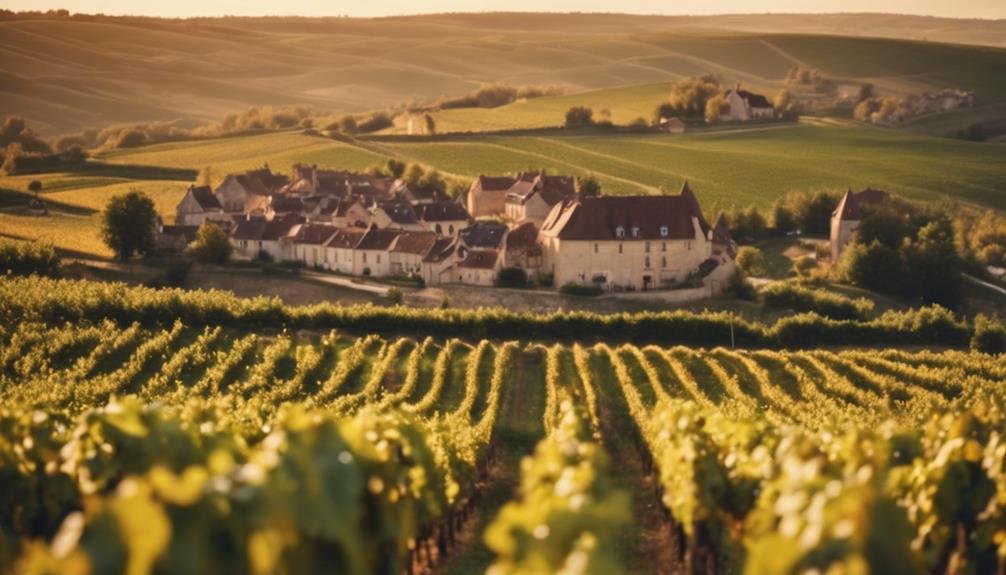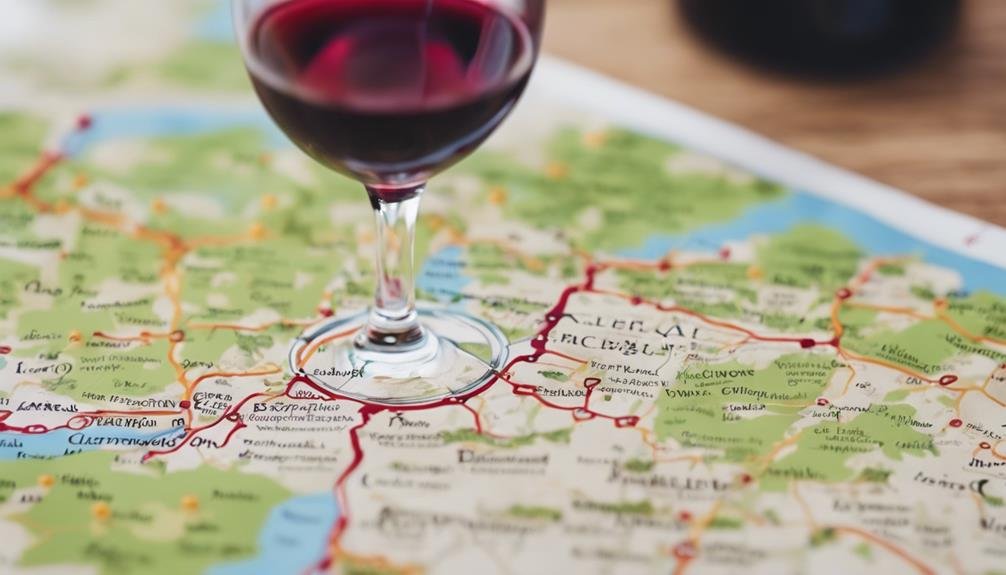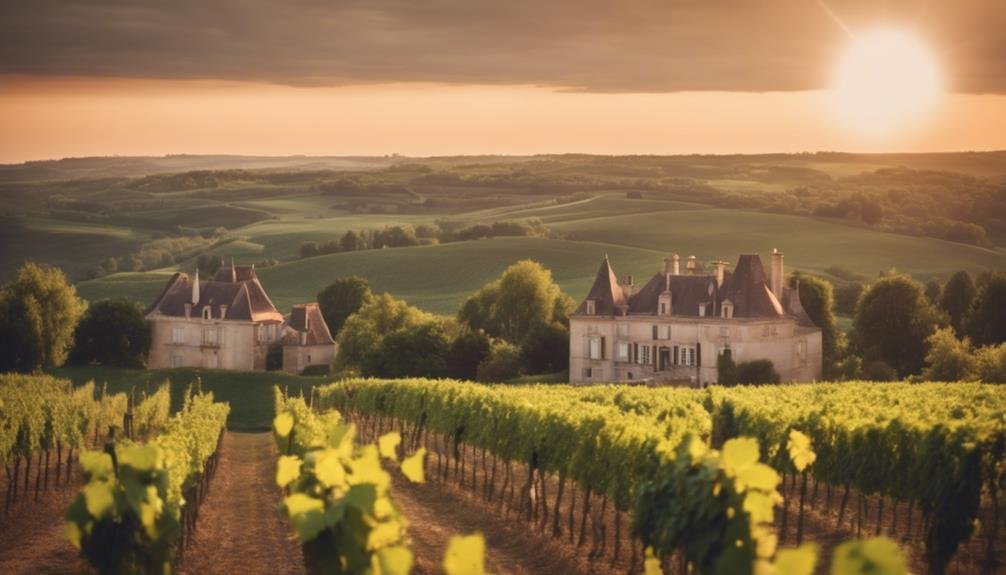Explore Burgundy's essence through its grape varieties like Pinot Noir and Chardonnay, essential for Bourgogne Rouge and Blanc. Terroir, from soil to climate, molds distinct flavors in regions like Côte de Beaune. Understand diverse terroir for varied tastes across Burgundy. Historical roots from Roman times enrich each sub-region's heritage. Côte Chalonnaise offers value Pinot Noir and Crémant. Mâconnais shines with budget-friendly Chardonnay and Pinot Noir. Uncover the intricate tapestry of Burgundy's wine regions to discover their rich heritage and terroir-driven flavors.
Burgundys Grape Varieties
What grape varieties are mainly focused on in Burgundy for its Bourgogne Rouge and Bourgogne Blanc wines? Burgundy is renowned for its emphasis on Pinot Noir for Bourgogne Rouge and Chardonnay for Bourgogne Blanc.
The grape varietal nuances in Burgundy play a pivotal role in crafting wines with distinct characteristics. Pinot Noir contributes to the elegance and complexity of Bourgogne Rouge, while Chardonnay adds a richness and aromatic profile to Bourgogne Blanc.
These grape varieties interact uniquely with the diverse soils of Burgundy, influencing the flavor profiles of the wines. The soil impact in Burgundy, characterized by limestone, marl, and clay, imparts minerality, structure, and finesse to the wines, further enhancing their quality and terroir-driven nature.
Terroir Influence on Burgundy Wines
The terroir in Burgundy plays a fundamental role in shaping the distinctive characteristics and quality of its wines. Terroir impact encompasses various factors such as soil composition, climate, vineyard orientation, and human intervention, all contributing to the unique flavor profiles found in Burgundy wines.
The region's diverse terroir gives rise to a wide range of flavors, from the elegant and floral notes in Chardonnay from Côte de Beaune to the robust and earthy tones in Pinot Noir from Côte de Nuits. Understanding how terroir influences flavor profiles allows wine enthusiasts to appreciate the nuanced differences in Burgundy wines and the essence of each sub-region's distinctive offerings.
Diverse Geographical Regions in Burgundy

Terroir's significant influence on Burgundy wines extends to the diverse geographical regions within the region, each contributing unique characteristics to the renowned wines produced.
Soil composition plays an essential role in shaping Burgundy's diverse terroirs, with variations in limestone, clay, and marl influencing the flavors and aromas of the wines.
Additionally, microclimates in Burgundy, such as the cooling effects of nearby rivers or the moderating influence of slopes, create ideal conditions for grape cultivation.
These microclimates contribute to the varying styles of wines produced across sub-regions like Chablis, Côte de Nuits, and Côte de Beaune.
Understanding the interplay between soil composition and microclimates in Burgundy is essential for appreciating the complexity and diversity of wines from this esteemed wine region.
Historical Evolution of Burgundy Wines
Throughout the centuries, the intricate tapestry of Burgundy's winemaking history has woven a narrative rich in tradition and innovation. Ancient viticulture in Burgundy dates back to the Romans in the 1st century AD, laying the foundation for the region's esteemed wine culture.
The influence of monks during the Middle Ages further shaped Burgundy's vineyards, with Catholic orders establishing and caring for many vineyards. This historical evolution continued through the French Revolution, which shifted vineyards back to local communities, fostering organic and bio-dynamic viticulture practices.
Each sub-region in Burgundy carries a unique historical background, contributing to the diversity and richness of the wines produced in this renowned winemaking region.
Distinctive Wines From Côte Chalonnaise

Known for its value-driven Pinot Noir and sparkling Crémant wines, Côte Chalonnaise in Burgundy showcases distinctive and remarkable wine offerings. Here are some key points about the wines from this region:
- Value Pinot: Côte Chalonnaise is celebrated for its affordable yet high-quality Pinot Noir, offering excellent value for wine enthusiasts.
- Sparkling Crémant: The region is also known for producing vibrant and invigorating Crémant wines, which are sparkling wines made using traditional methods.
- Diverse Wine Styles: Unique appellations like Bouzeron and Rully in Côte Chalonnaise highlight a range of diverse wine styles, showcasing the versatility of the region.
- Distinct Terroir Influence: Wines from Côte Chalonnaise exhibit distinct characteristics influenced by the region's specific terroir, making them stand out in the world of Burgundian wines.
Mâconnais: Burgundys Largest Wine Region
Mâconnais, as Burgundy's largest wine region, is renowned for its diverse and value-driven Chardonnay wines. The region offers a wide range of Chardonnay diversity, from smooth oaked expressions to vibrant unoaked styles.
Mâconnais is also known for its value Pinot Noir, which can range from rustic to elegant profiles. The terroir of Mâconnais plays an important role in shaping the characteristics of these wines, with vineyard placement and climate influencing the grape varieties grown.
This region's wines showcase a unique balance of quality and affordability, making them accessible to wine enthusiasts looking for excellent value. Mâconnais continues to attract attention for its exceptional Chardonnays and remarkable Pinot Noirs, solidifying its position as a key player in Burgundy's winemaking landscape.
Burgundy Wine Classifications Explained

Burgundy wine classifications provide a structured framework that categorizes wines based on quality and origin, offering valuable insights into the uniqueness and prestige of wines from this renowned French region. Understanding these classifications is essential for appreciating the diverse range of wines produced in Burgundy. Here are key points to ponder:
- Grand Cru: Represents the highest quality wines from the best vineyard sites.
- Premier Cru: Denotes wines from specific premier vineyards, showcasing exceptional quality.
- Village Wines: Reflect the distinct characteristics of individual villages within Burgundy.
- Regional Wines: Offer a broader representation of the Burgundy region, providing accessible entry-level options for wine enthusiasts.
These classification nuances highlight the regional expressions and complexities that make Burgundy wines so esteemed.
Frequently Asked Questions
How Do Burgundy Winemakers Address Climate Change Challenges?
Burgundy winemakers address climate change challenges by implementing sustainability practices, adapting vineyard management techniques, and embracing innovative technologies. They focus on future solutions to preserve the region's terroir while ensuring the quality and uniqueness of their wines.
What Is the Impact of Biodiversity on Burgundy Wine Quality?
The impact of biodiversity on Burgundy wine quality can be significant. Biodiversity enhances soil health, which in turn influences terroir. Diverse ecosystems promote vine resilience, improved grape quality, and unique flavors in the wines, reflecting the essence of the region.
How Do Traditional Winemaking Techniques Influence Burgundy Wines?
Traditional winemaking techniques deeply influence Burgundy wines, shaping their elegance and complexity. From hand-harvesting to oak barrel aging, each practice reflects Burgundy's rich terroir and sustainability ethos. These methods enhance the region's distinctive wine profiles.
What Role Do Local Cooperatives Play in Burgundys Wine Industry?
Local cooperatives in Burgundy play a pivotal role in the wine industry through fostering partnerships among small vineyard owners, pooling resources for winemaking, and collectively marketing their wines. Their influence enhances the diversity and accessibility of Burgundian wines.
How Do Burgundy Winemakers Balance Tradition and Innovation in Their Practices?
Burgundy winemakers blend tradition with innovation by harmonizing history and progress, preserving old practices while embracing new techniques. Balancing old-world expertise with modern advancements guarantees the continuation of Burgundy's esteemed winemaking legacy.
Conclusion
To sum up, Burgundy's wine regions showcase a rich tapestry of grape varieties, terroir influences, and historical evolution that contribute to the exceptional quality of its wines.
One interesting statistic to note is that Burgundy produces over 180 million bottles of wine annually, with a significant portion being classified as Grand Cru or Premier Cru.
This highlights the region's commitment to quality and tradition, making Burgundy a true gem in the world of fine wines.
